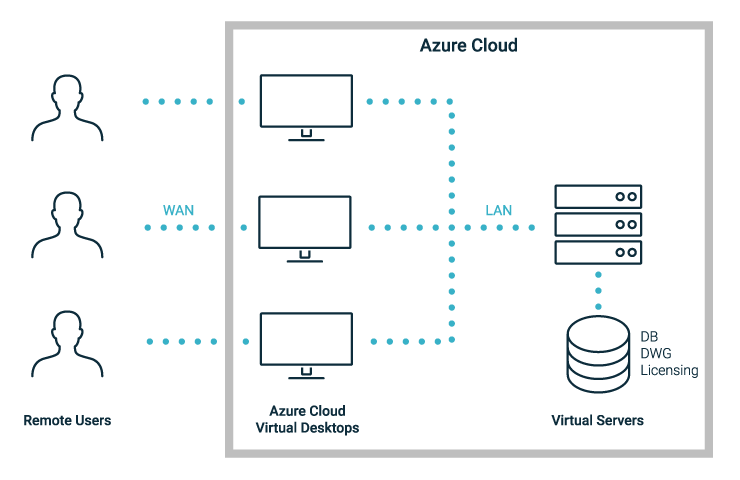今日、造船所はクラウド技術に精通しており、近々導入を検討しなければならないものであることを知っています。 しかし、その潜在的な変化には、何が必要なのかという不安がつきまといます。 しかし、ほとんどの造船会社にとって、仮想化を進めることは、いくつかの重要な方法でリスクを軽減することができます。
分散型アクセシビリティ
covid-19による制限や混乱は、従業員がリモートで作業しているプロジェクトにアクセスできるようにすることが有益であることの極端な例であった。 このように、造船プロジェクトでは、遠隔地にいるチームや地理的に分散している下請け業者が共有するプロジェクトにアクセスできるようにする必要が出てきています。
一部または全部のワークステーションにリモートアクセスできる仮想化環境を構築することで、チームが仕事にアクセスできないまま放置されるリスクを低減します。 また、ワークフローの要求の変化に応じて、部門がリモートワーカーや契約社員を必要な場所に簡単に追加することができます。

もし、このような分散型業務がロードマップ上にあるのであれば、今一度、現在使用しているソリューションがクラウド環境に容易に移行できるかどうかを確認する良い機会だと思います。 理想を言えば、既存のベンダーは、Microsoft AzureやAWSのような主要プロバイダーの環境に自社のソリューションを設定した経験を持つことです。
強化されたセキュリティ
また、造船会社にとって、セキュリティは今、最も重要な課題です。 容器の複雑さや使用するツールの数に応じて、システムの漏洩や情報漏えいのリスクは増大する可能性があります。 一部のシステムをクラウド基盤に切り替えることで、こうしたリスクを軽減することができます。
クラウドシステムでは、誰がデータにアクセスし、何をすることができるかという権限を簡単に変更・修正することができます。 例えば、外部のチームがあなたのデータを扱う必要があるとき、彼らにモデルを操作するための読み取り専用アクセス権を与え、作業が終わったらそれを取り消すことで、彼らがあなたのIPをダウンロードする必要がありません。
また、クラウド事業者が率先してセキュリティパッチを適用し、安全なコンピューティング環境を提供します。 Microsoft AzureやAWSなど、主要なクラウドプロバイダーのほとんどは、最高レベルのセキュリティクリアランスの要件を満たす環境を提供しています。
ITオペレーションを効率化する
クラウド技術を活用することで、IT業務を効率化し、本業である造船業に注力しやすくするチャンスです。 クラウド環境は、ハードウェアの購入やプロビジョニングの長いサイクルを回避し、サーバー管理などの活動を簡素化することを意味します。
また、クラウドソリューションは業界標準のAPIをサポートしており、造船所の既存ソリューションとの統合が容易です。 これらのAPIを使用することで、開始時に必要なカスタム開発の量を最小限に抑え、すでに導入している一部のツールでしか動作しない統合のリスクをヘッジすることができます。
新しいテクノロジーソリューションの活用
造船所が新たなデジタル技術を活用しようとするとき、クラウドソリューションは、その導入の課題のいくつかを解決する道筋を示すことができます。 デジタル・トランスフォーメーションの一環として、クラウド・インフラは造船所全体のデジタル技術をサポートし、設計、生産、購買、オペレーションを統合することが可能です。
また、従来はなかなか実現できなかったある種の活動も、この技術によって可能になります。 例えば、クラウド・ソリューションがあれば、造船所では、重要な現場イベントの発生時にモバイル・デバイスに通知をプッシュしたり、その場で素早く承認したり、タブレットを備えたデジタル現場での情報の取得とプッシュの方法を簡素化したりすることができます。
コスト/投資の簡素化
多くの造船会社にとって、設備投資額の削減は今、最も重要な課題です。 多くのクラウドソリューションの特徴であるサブスクリプションベースのコスト構造は、柔軟性を提供し、ハードウェア費用を継続的な運用費用にシフトするのに役立ちます。 また、物理的なコンピューティングインフラにありがちな購入サイクルに悩まされることもありません。
一般的に、ソリューションは柔軟なライセンスオプションを提供しており、チームは継続的な作業量に合わせてダイナミックにスケールアップとスケールダウンを行うことができます。
造船所にクラウドを導入する
今後数年間で、私たちのビジネスのほとんどがクラウド化されるとは考えにくいですが、クラウドソリューションは、造船の一部のリスクを軽減する機会を提供します。 分散型アクセス、セキュリティ強化、IT運用の合理化、新しいテクノロジーソリューションの活用、投資戦略の簡素化など、今日、すべての要素が関与している可能性があります。
しかし、クラウド技術は今大きなトレンドなので、自分のビジネスのニーズとどこに価値を見出せるかを現実的に考えることが重要です。 話題性に釣られて、良い機会でもないのにクラウドインフラを導入してしまうと、効果のない投資になってしまいます。 遠隔地の下請け業者やクラウドベースのデザインレビューなど、競争力を高めることができるリスクの低い取り組みを特定することは、ワークフローにクラウドインフラの価値を導入する方法として有効です。
エンジニアリング・プラットフォーム、PLM、ERP、MESなどのツールが、Microsoft AzureやAWSなどのクラウドプロバイダーでセットアップできることを確認することは、最初の大きな一歩です。 その知識があれば、チームは自信を持ってクラウド導入の機会を探ることができます。
